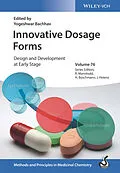Teaches future and current drug developers the latest innovations in drug formulation design and optimization This highly accessible, practice-oriented book examines current approaches in the development of drug formulations for preclinical and clinical studies, including the use of functional excipients to enhance solubility and stability. It covers oral, intravenous, topical, and parenteral administration routes. The book also discusses safety aspects of drugs and excipients, as well as regulatory issues relevant to formulation. Innovative Dosage Forms: Design and Development at Early Stage starts with a look at the impact of the polymorphic form of drugs on the preformulation and formulation development. It then offers readers reliable strategies for the formulation development of poorly soluble drugs. The book also studies the role of reactive impurities from the excipients on the formulation shelf life; preclinical formulation assessment of new chemical entities; and regulatory aspects for formulation design. Other chapters cover innovative formulations for special indications, including oncology injectables, delayed release and depot formulations; accessing pharmacokinetics of various dosage forms; physical characterization techniques to assess amorphous nature; novel formulations for protein oral dosage; and more. -Provides information that is essential for the drug development effort -Presents the latest advances in the field and describes in detail innovative formulations, such as nanosuspensions, micelles, and cocrystals -Describes current approaches in early pre-formulation to achieve the best in vivo results -Addresses regulatory and safety aspects, which are key considerations for pharmaceutical companies -Includes case studies from recent drug development programs to illustrate the practical challenges of preformulation design Innovative Dosage Forms: Design and Development at Early Stage provides valuable benefits to interdisciplinary drug discovery teams working in industry and academia and will appeal to medicinal chemists, pharmaceutical chemists, and pharmacologists.
Autorentext
Yogeshwar Bachhav, PhD, is currently working as consultant to the pharmaceutical industry in Europe and Asia supporting the pharmaceutical development of new and approved drugs. He is a pharmacist by training and completed a PhD at the Institute of Chemical Technology, Matunga, Mumbai (India) in 2007. He has worked in Europe for more than 10 years with different start-up and mid-sized biotech/pharmaceutical companies. During this tenure, he has successfully managed pharmaceutical development of several projects from POC to phase 1, 2 and 3 clinical trials.
Inhalt
Preface xvii
1 Impact of the Polymorphic Form of Drugs/NCEs on Preformulation and Formulation Development 1
MHD Bashir Alsirawan and Anant Paradkar
1.1 Introduction 1
1.1.1 Background 1
1.1.2 Types of Polymorphism 2
1.1.3 Thermodynamic-Based Classification of Polymorphism 4
1.1.4 Concomitant Polymorphism 6
1.1.5 Debatable Polymorphism Cases 7
1.2 Polymorphism Impact on Drug/Excipient Properties 9
1.2.1 Physicochemical Properties 10
1.2.2 Mechanical Properties 11
1.2.3 Impact of Polymorphism on In Vivo Performance 13
1.3 Critical Impact of Polymorphic Form of API on Processing and Formulation 22
1.3.1 Process-induced Transformation Types 23
1.3.1.1 Grinding-induced Transitions 23
1.4 Conclusion 37
References 38
2 Strategies for the Formulation Development of Poorly Soluble Drugs via Oral Route 49
Sanket Shah, Abhijit Date, and Renè Holm
2.1 Introduction 50
2.2 Quality by Testing (QbT) and Quality by Design (QbD) 50
2.3 Linking the Formulation to the Clinical Phase 52
2.4 Defining the Formulation Strategy 55
2.5 Nanosuspensions 58
2.5.1 Description 58
2.5.2 Method of Manufacturing 59
2.5.3 Characterization of Nanosuspensions 63
2.6 Solid Dispersion 64
2.6.1 Description 65
2.6.2 Method of Manufacturing 66
2.6.3 Characterization 68
2.7 Lipid-Based Drug Delivery Systems 69
2.7.1 Description 70
2.7.2 Method of Manufacture 71
2.7.3 Characterization 75
2.7.4 Role of API Property on Lipid-Based DDS 76
2.8 Micellar System 76
2.8.1 Description 76
2.8.2 Formulation Development and Optimization 80
2.8.3 Characterization 81
2.9 Mesoporous Silica Particles 81
2.9.1 Description 82
2.9.2 Method of Manufacturing and Characterization 83
2.9.3 Case Study on the in Vivo Efficacy of Mesoporous Silica Particles 84
2.10 Conclusion 84
References 85
3 Effect of Residual Reactive Impurities in Excipients on the Stability of Pharmaceutical Products 91
Ankit Sharma
3.1 Introduction 91
3.2 Reactive Impurities in the Excipients and Their Impact on Drug Stability 92
3.3 Impact of Reactive Impurities on DrugExcipient Compatibility 93
3.3.1 Physical Interactions 93
3.3.2 Chemical Interactions 94
3.3.3 Oxidative Degradation 94
3.3.4 Peroxides 95
3.3.5 Transition Metal Impurities 96
3.3.6 Condensation Reactions 99
3.3.7 Aldehyde Impurities 99
3.3.8 Reducing Sugars 102
3.3.9 Organic Acids 103
3.3.10 Hydrolytic Degradation 105
3.4 Risk Assessment for API Incompatibilities and Mitigation Strategies 107
3.5 Assessment of Incompatibilities of API with Excipients 108
3.6 Design and Selection of Drug Substance 109
3.7 Formulation Strategies to Circumvent API Degradation 110
3.8 Inhibition of Oxidative Degradation 110
3.8.1 Initiation Inhibitors 111
3.8.2 Propagation Inhibitors 111
3.8.3 Selection of Antioxidant 112
3.9 Super-Refined Excipients 113
3.9.1 Polyethylene Glycols (PEG) 114
3.9.2 Polysorbates 114
3.9.3 Fatty Acids 115
3.10 Packaging and Storage 115
3.11 Concluding Remarks 116
References 116
4 Preclinical Formulation Assessment of NCEs 119
Raju Saka, Priyadarshini Sathe,Wahid Khan, and Sachin Dubey
4.1 Introduction 120
4.2 Significance of Various Properties of NCEs in Early Drug Discovery 122
4.2.1 Solubility 123
4.2.2 Permeability 124
4.2.3 Stability 125
